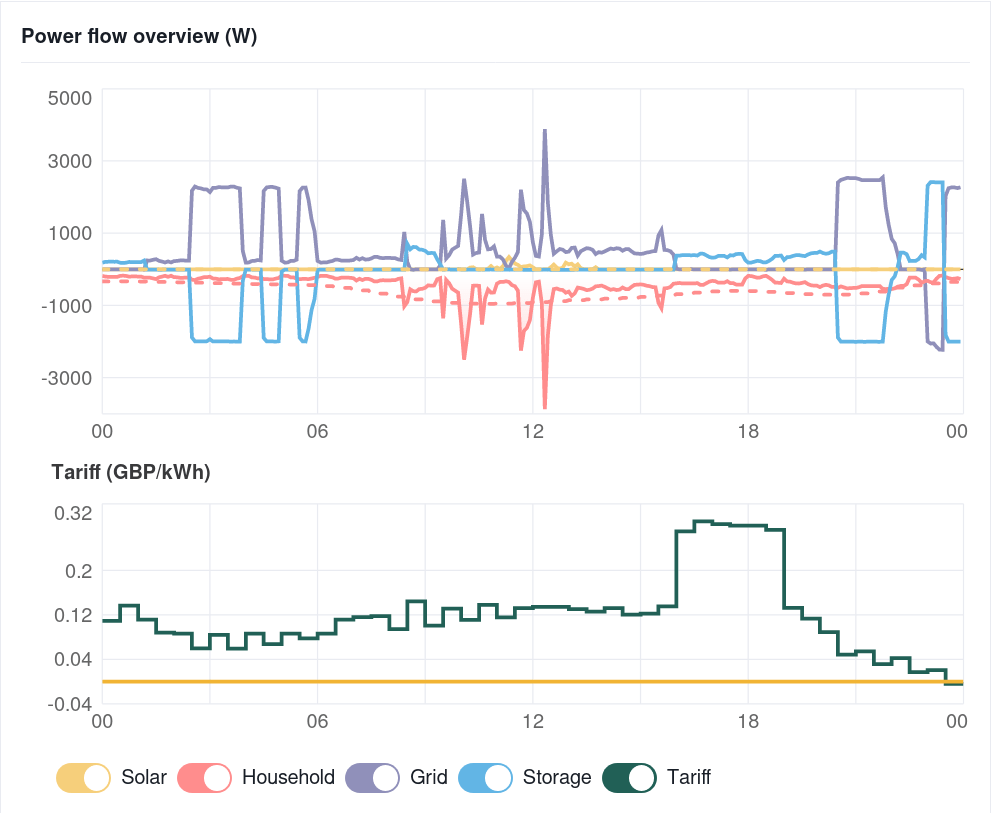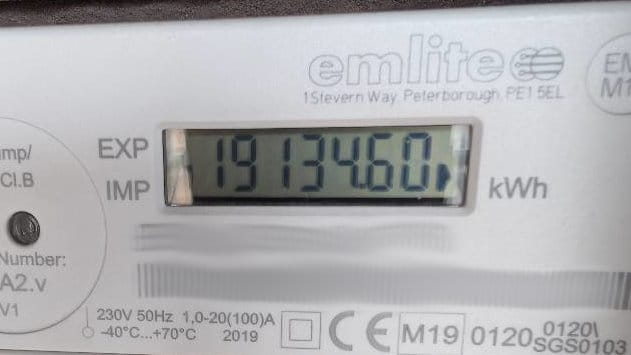We pay 12p / kWh for electricity - thanks to a smart tariff and battery
I love my solar panels. But the solar panels don't love the British midwinter. Most of the year, my panels produce more electricity than I can use. But in winter we're lucky if they produce 3kWh per day - and most of the time it is considerably less.
So our winter electricity bills must be massive, right?
Nope.
The normal cost per kWh is 28.5p (including VAT). We're paying less than half that - 12.4p per kWh.

This is thanks to two things - a smart tariff and a home battery.
The Octopus smart tariff charges us a variable amount throughout the day. Every 30 minutes the prices change to reflect the demands on the grid. During peak times, it can go as high as £1/kWh. That's a good incentive not to run the tumble-dryer at the same time as the rest of the country is cooking dinner!
During quieter times, the price of electricity drops - there isn't much demand at 3AM so prices fall. Sometimes they fall to zero. Other times, they fall into negative territory and we get paid to use electricity.
Now, that's all well and good, but most people don't want to shift their consumption habits. The dishwasher goes on when it is full and dinner is cooked before Coronation Street starts. That's where the battery comes in.
We have a 4.8kWh battery. It is hooked up to the Internet and knows what our energy prices are minute-to-minute. When electricity is cheap, it charges up from the grid. When electricity is expensive, it discharges into our home. If we boil the kettle at 7pm, the sensors on the battery detect that we're using expensive electricity and starts outputting stored electricity.
Essentially, we don't have to alter our lifestyle at all. Here's a typical December day. The graph is quite complicated, so let me step you through it.

The bottom graph shows how expensive it is to buy electricity throughout the day. As you can see, there is a peak in the early evening when electricity becomes expensive.
The top graph has two interesting lines on it. The purple line shows how much electricity we're drawing from the grid, the blue line shows what the battery is doing. Early in the morning electricity is cheap - you can see the purple line rising as the blue line falls. That shows the battery is charging. You will notice that it only charges at the cheapest possible times.
In the evening, you can see the purple line dip to zero and the blue line rise. That shows the battery is discharging into our home and there in no electricity being purchased from the grid. There's a similar dip at about 0830 when there's a little spike in price. Clever battery!
I want to stress that is is all automated. I don't have to do a single thing. The battery speaks directly to my electricity provider to get the half-hourly costs. The battery can predict what our usage will be, but keeps most of the electricity for the expensive times of day. Our smart meter sends our usage back to the energy company automatically.
Savings
Against a normal tariff of 28.5p/kWh, I'm paying 12.4p/kWh. That's a saving of 16.1p/kWh.
The bill above shows 320kWh per month, which means a saving of £51 from the electricity I buy. That's approximately a 55% discount.
We've had that battery since August, so about 5 months. In that time it has saved us approximately 500kWh. We only moved onto the smart tariff a few months ago, so work out the savings there is complex - but I estimate it's about £130.
December is a high use month (lots of lights on and oven cooking). During summer, the battery mostly fills up with free solar power. It is hard to predict exactly what we'll save in a year, but it should easily shave 50% off our electricity bills.
Cost
But, of course, there's no such thing as a free lunch. Our 4.8kWh battery cost about £2,700 to supply and install. That's a large chunk of change. Based on our current projections, its payback period should be about 7 years. Of course, if electricity prices rise significantly, the payback period will shorten.
Solar panels are also expensive to install - between £4,000 and £12,000 depending on your property and how complex your roof is. They mean we pay virtually nothing for electricity in spring and summer. Again, the payback period is under a decade.
We can also sell our excess solar back to the grid. In theory we could also buy cheap electricity in the morning, store it in the battery, and then sell it back at peak times. In practice it isn't worth it; the cost of buying electricity at peak is higher than the price we could sell it for. So it makes sense to use the power rather than selling it.
If you can afford the large up-front capital costs, solar + battery allows you to make massive savings with a dynamic tariff. In times of solar excess, we pay close to nothing per kWh. In winter, we shift our consumption to pay at the cheap rate.
Effectively, it's like pre-purchasing all your electricity for the next decade.
Final thoughts
There's no doubt that the cost makes this prohibitive to many people. Ideally, the state should be mandating that all new homes have solar panels and space for optional batteries. We also need V2G (Vehicle to Grid) to allow electric cars to act as home batteries.
But there's no doubt that these technologies actually work! Yes, solar works in rainy London. And, yes, even fairly small batteries can make a significant difference in winter. We're on the cusp of a domestic energy revolution. When coupled with a smart tariff, it means people don't have to change the way they behave in order to save energy.
 Actually, I *do* want IoT kitchen gadgets
Actually, I *do* want IoT kitchen gadgets
 Fifteen MegaWatt Hours from Sunshine - Four Years with Solar Panels in London
Fifteen MegaWatt Hours from Sunshine - Four Years with Solar Panels in London
 One MegaWattHour of Battery Power!
One MegaWattHour of Battery Power!
 One Year With A Solar Battery
One Year With A Solar Battery
 What does a "Personal Net Zero" look like?
What does a "Personal Net Zero" look like?
It would also be interesting to know how much more a larger battery would save (alternatively, how often is the battery fully drained). And rain in London might even be an advantage, as it flushes away dust that would impair the efficiency of the solar panels.
Reading about how Terence Eden has integrated solar panels, smart metering and a fair-sized battery makes me very envious. I've never heard of anything like that on offer in Italy and as a renter rather than owner, there is absolutely no incentive for me to find out more. But I would genuinely love to pre-pay for my electricity for 10 years
| Reply to original comment on stream.jeremycherfas.net
@blog
I seriously looked at it last autumn and had several companies come out to quote.
A couple seemed dodgy, but most were around £10k all in, about double what I could afford. Long term it would be worth it but a serious chunk upfront.
One was desperate to sell me a heat pump too. The figures they claimed were impressive and I was keen but it would have brought the bill to over £12k.
Still waiting on a lottery win to become energy efficient - which says everything about the problem!
@Edent our install has been delayed a few months, but at least we will kick off generating more power. We'll have a big battery, so hope that will improve the savings
| Reply to original comment on mastodon.org.uk
@Edent I totally need to work out how to get my Solis inverter to automatically change settings based on price! It doesn't seem to be quite as clever as your system! (We increased the size of our batteries from 4.8 to 7.2 KWh this summer though, and even just that has saved us money compared to last year).
| Reply to original comment on tech.lgbt
Alan says:
I don't think Solis is up to the job sadly (I have the same). I have been using the Cosy Tariff which has three periods of cheap charging a day in exchange for a pricier period 4-7pm. This works well apart from during the cold snap where our heat pump use was too much for the battery to cover. Even then - we still get to use a lot of cheaper electricity than we would otherwise
@lnr I recognise the graphs - that’s a Moixa battery system, same as I have
| Reply to original comment on thegoatery.dyndns.org
+1 for vehicle to grid! All that battery sitting there not doing anything useful 🙁
| Reply to original comment on bsky.app
More comments on Mastodon.